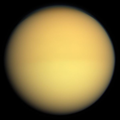Файл:Two Halves of Titan.png
Two_Halves_of_Titan.png (600 × 600 нокта, файл зурлыгы: 108 Кб, MIME төре: image/png)
Файл тарихы
Файлның нинди булганлыгын күрү өчен «дата/вакыт» дигәненә басыгыз.
| Дата/вакыт | Кече рәсем | Үлчәмнәре | Кулланучы | Искәрмә | |
|---|---|---|---|---|---|
| агымдагы | 14 июл 2015, 12:34 |  | 600 × 600 (108 Кб) | JorisvS | rv: only black is cropped away |
| 14 июл 2015, 11:08 |  | 796 × 798 (290 Кб) | Crisco 1492 | Reverted to version as of 05:14, 30 December 2010; too tight crop damages composition | |
| 9 гый 2011, 02:19 |  | 600 × 600 (108 Кб) | Antonsusi | Crop canvas of no interest | |
| 30 дек 2010, 05:14 |  | 796 × 798 (290 Кб) | Materialscientist | crop whitespace | |
| 16 окт 2009, 15:15 |  | 1024 × 1024 (298 Кб) | Originalwana | {{Information |Description={{en|1=Seasonal changes in the atmosphere of Saturn's largest moon are captured in this natural colour image which shows Titan with a slightly darker top half and a slightly lighter bottom half. Titan's a |
Файлны куллану
Бу файлны кулланган битләр юк.
Файлның гомуми кулланышы
Әлеге файл аста бирелгән викиларда куллана:
- af.wikipedia.org проектында куллану
- ar.wikipedia.org проектында куллану
- ast.wikipedia.org проектында куллану
- as.wikipedia.org проектында куллану
- be.wikipedia.org проектында куллану
- bg.wikipedia.org проектында куллану
- bh.wikipedia.org проектында куллану
- bs.wikipedia.org проектында куллану
- ca.wikipedia.org проектында куллану
- cdo.wikipedia.org проектында куллану
- ckb.wikipedia.org проектында куллану
- cs.wikipedia.org проектында куллану
- de.wikipedia.org проектында куллану
- dsb.wikipedia.org проектында куллану
- eml.wikipedia.org проектында куллану
- en.wikipedia.org проектында куллану
Бу файлның гомуми кулланышын карау.



